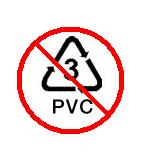Polyvinyle Chrolide (PVC) is one of the most widely used plastic materials. PVC is approximately 57% chlorine by mass. Petroleum by-products are also used in the PVC production process. About 50% of PVC use is for construction, replacing traditional building materials like wood, concrete, and metal pipes. PVC is often combined with plasticizers (especially phthalates) to make it more soft and flexible for use in products such as clothing, upholstery, plastic figurines, and wiring insulation.
PVC used in consumer products pose health concerns due to the leaching of phthalates over time. Of particular concern are products that come into oral contact with humans, like water bottles and cups, food containers, children's toys. Per the US EPA, no information is currently available regarding the amount of vinyl chloride released from PVC pipes into drinking water. The U.S. government now regulates the amount of vinyl chloride contained in materials used for food packaging.
PVC products can also be a source of chemical outgassing. You've probably been aware of this phenomenon when entering a new car (the "new car smell") or removing a plastic shower curtain from its packaging. In 2004, European researchers found a statistical link between allergies in children and indoor air levels of phthalates commonly found in vinyl flooring.
In addition to health issues, PVC raises many environmental concerns. Both the manufacture of PVCs and their eventual incineration at the end of their lifecycle release toxic dioxins, furans, and hydrogen chloride. These fumes are carcinogenic, mutagenic, and teratagenic. Dioxins have a long life in the environment and when airborne, can travel long distances. The US CDC found that people working in PVC production facilities have numerous health risks related to immune reactions, such as nerve damage, liver changes, poor blood flow, bone degredation, and skin conditions.<br
The California legislature is considering banning the use of PVC in consumer packaging due to the threats it poses to human and environmental health and its effect on the recycling stream.

As a rule of thumb, try to avoid PVC plastic items and containers - you can identify them by the Number 3 plastic recycle symbol.
